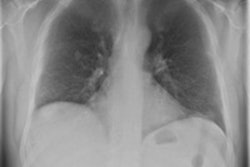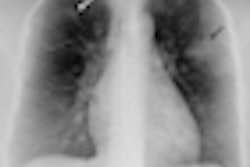Two new studies being presented at this weekend's 2012 European Society of Thoracic Imaging (ESTI) meeting in London show how bone suppression software by Riverain Technologies significantly improves radiologists' ability to detect potentially cancerous lung nodules in x-ray images, the company said in a statement.
The first study, conducted at University Hospital Bern, Switzerland, compared Riverain's ClearRead bone suppression software with chest x-ray and dual-energy subtraction (DES) imaging in 101 patients with 155 lung nodules, alone and in combination with computer-aided detection (CAD). The results showed that the bone suppression software is as good as DES at detecting lung nodules while producing superior image quality, according to the CAD developer.
The greatest number of nodules was detected in bone-suppressed images with CAD markings, the company said. Mean sensitivities for nodule detection were 46.9% using conventional x-ray, 49.2% using a single-shot DES system, 49.7% using SoftView 2.0 (an earlier version of Riverain's ClearRead Bone Suppression), and 51.6% using SoftView 2.0 plus OnGuard 5.1 (an earlier version Riverain's ClearRead + Detect software). However, the overall diagnostic performance with the modalities was not significantly different, Riverain said.
In a second study to be presented at ESTI, eight radiologists at Radboud University Nijmegen Medical Centre (RUNMC) and the Meander Medical Centre in Amersfoort, Netherlands, reviewed chest x-ray images in 108 patients with a solitary CT-proven lung nodule and 192 patients without nodules. On average, readers found 14.4% of lung nodules using Riverain's bone suppression technology (SoftView 2.4, now called ClearRead Bone Suppression) that were missed when they used conventional x-ray alone, without an increase in false positives, the company said.
Riverain believes the studies show that the combination of chest x-ray with bone suppression software might be a cost-effective alternative to DES imaging.



















